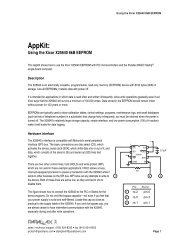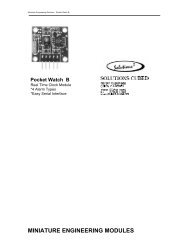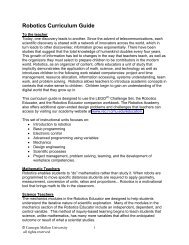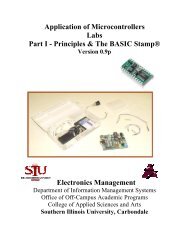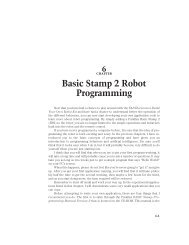Activity: Build an Earthquake City!!! GRADE LEVELS: 6-8 ... - ISL
Activity: Build an Earthquake City!!! GRADE LEVELS: 6-8 ... - ISL
Activity: Build an Earthquake City!!! GRADE LEVELS: 6-8 ... - ISL
Create successful ePaper yourself
Turn your PDF publications into a flip-book with our unique Google optimized e-Paper software.
<strong>Activity</strong>: <strong>Build</strong> <strong>an</strong> <strong>Earthquake</strong> <strong>City</strong>!!!<br />
<strong>GRADE</strong> <strong>LEVELS</strong>: 6-8<br />
SUMMARY:<br />
Students will build a city out of sugar cubes, bouillon cubes, <strong>an</strong>d gelatin cubes.<br />
The city will be put through simulated earthquakes to see which cube structures<br />
withst<strong>an</strong>d the shaking the best.<br />
LEVEL OF DIFFICULTY [1 = Least Difficult: 5 = Most Difficult]<br />
1-least difficult<br />
TIME REQUIRED<br />
20 minutes for construction<br />
30 minutes for testing<br />
COST<br />
$5.00<br />
STANDARDS:<br />
2.5 Explain how such design features as size, shape, weight, function <strong>an</strong>d cost limitations (i.e.,<br />
ergonomics) would affect the construction of a given prototype.<br />
1.1 Given a design task, identify appropriate materials (e.g., wood, paper, plastic, aggregates,<br />
ceramics, metals, solvents, adhesives) based on specific properties <strong>an</strong>d characteristics (i.e., weight,<br />
strength, hardness <strong>an</strong>d flexibility).<br />
WHAT WILL THE STUDENTS LEARN?<br />
The effect of earthquakes on structures.<br />
The import<strong>an</strong>ce of strong buildings to prevent destruction by earthquakes.<br />
How the epicenter of <strong>an</strong> earthquake affects buildings.<br />
Different materials may be used in the construction of buildings.<br />
www.prek-12engineering.org 1<br />
Copyright © 2001<br />
All Rights Reserved
BACKGROUND INFORMATION:<br />
When there is <strong>an</strong> earthquake, energy travels through the earth <strong>an</strong>d c<strong>an</strong> cause<br />
damage to buildings <strong>an</strong>d other structures far away. The amount of damage caused<br />
by <strong>an</strong> earthquake depends on several things such as the strength of the earthquake,<br />
how long it lasts, <strong>an</strong>d where it happens.<br />
The epicenter of <strong>an</strong> earthquake is the point on the earth's surface directly above<br />
where <strong>an</strong> earthquake starts, or where the shaking begins. The damage will<br />
typically be the greatest at the epicenter.<br />
Today, some skyscrapers are made of more flexible materials so that they bend<br />
<strong>an</strong>d sway during <strong>an</strong> earthquake <strong>an</strong>d do not fall down as easily.<br />
RESOURCES:<br />
http://earthquake.usgs.gov/4kids excellent resource for more background<br />
information on earthquakes.<br />
Books: <strong>Earthquake</strong>s by Seymour Simon; Mulberry Books, April 1995<br />
MATERIALS:<br />
Box with smooth bottom, at least 25-cm wide X 20-cm long<br />
Sugar cubes<br />
Bouillon cubes<br />
Gelatin cubes (Follow instructions on box to make, but use 1/3 as much water as<br />
the recipe calls for. Use a p<strong>an</strong> or ice cube tray. Chill until very firm <strong>an</strong>d cut into<br />
small cubes, about the size of sugar <strong>an</strong>d bouillon cubes).<br />
Pencil<br />
Ruler<br />
(Optional: wood <strong>an</strong>d plastic cubes as additional building materials)<br />
PREPARATION:<br />
Buy or assemble materials<br />
Prepare gelatin cubes<br />
Discuss with the class what <strong>an</strong> earthquake is <strong>an</strong>d what the epicenter of <strong>an</strong><br />
earthquake is.<br />
www.prek-12engineering.org 2<br />
Copyright © 2001<br />
All Rights Reserved
DIRECTIONS:<br />
1. Split the students into small groups or pairs <strong>an</strong>d give each group a box bottom.<br />
2. Using the pencil <strong>an</strong>d ruler, have the students create a grid on the box by<br />
drawing 4 vertical lines <strong>an</strong>d 5 horizontal lines; each line should be 5-cm apart.<br />
Label the vertical lines 1 st Avenue, 2 nd Avenue, 3 rd Avenue, etc., <strong>an</strong>d the<br />
horizontal lines A Street, B Street, C Street, etc. This is the earthquake city.<br />
3. To show that earthquakes c<strong>an</strong> cause damage to buildings, have the students<br />
build three sugar cube skyscrapers, each one five sugar cubes tall. <strong>Build</strong> the<br />
skyscrapers at the following corners: A <strong>an</strong>d 1 st , B <strong>an</strong>d 2 nd , C <strong>an</strong>d 3 rd .<br />
4. Now have the students simulate <strong>an</strong> earthquake by tapping on the corner of D<br />
<strong>an</strong>d 4 th with the eraser of a pencil. They should continue to tap until at least one<br />
cube from each skyscraper falls. Ask: Which skyscraper falls first? In a real<br />
earthquake, do you think more damage would happen in one place th<strong>an</strong> <strong>an</strong>other?<br />
Where would the most damage happen?<br />
5. The students should try step 4 again, but use different strength taps,<br />
representing hard vibrations <strong>an</strong>d soft vibrations. They should determine how<br />
m<strong>an</strong>y hard or soft vibrations it takes to knock over buildings different dist<strong>an</strong>ces<br />
away from the epicenter.<br />
6. Have students record results in a chart containing the location of the skyscraper<br />
<strong>an</strong>d when it fell.<br />
7. Now allow the students to experiment with different types of cubes. Encourage<br />
them to create skyscrapers from a variety of blocks <strong>an</strong>d of different heights.<br />
8. After they have had time to experiment with the different types of blocks, each<br />
group should build a city of skyscrapers. The cities may be as large as they wish<br />
but must have at least five skyscrapers of different heights.<br />
9. Once they have completed their cities, go around to each group <strong>an</strong>d tap with<br />
your pencil at a corner in the city to test how earthquake resist<strong>an</strong>t they are.<br />
10. After the cities have been tested, students should put away materials <strong>an</strong>d you<br />
c<strong>an</strong> have a discussion about what the students discovered.<br />
www.prek-12engineering.org 3<br />
Copyright © 2001<br />
All Rights Reserved
INVESTIGATING QUESTIONS:<br />
Why is it useful to build skyscrapers out of different materials?<br />
Which materials were the best to use for taller buildings?<br />
Which cubes were the most earthquake resist<strong>an</strong>t? Why?<br />
Which skyscrapers fell first in the earthquakes? Where were they located in<br />
respect to the epicenter of the earthquake?<br />
What happens when the top of a skyscraper is heavier th<strong>an</strong> the bottom, or when<br />
the bottom is heavier th<strong>an</strong> the top?<br />
REFERENCES:<br />
Kessler, James H. <strong>an</strong>d Andrea Bennett. The Best of Wonderscience: elementary<br />
science activities. Boston: Delmar Publishers, 1997. ISBN: 0827380941 p. 322-<br />
324.*<br />
*Adapted with permission from The Best of Wonderscience, Copyright 1997,<br />
Americ<strong>an</strong> Chemical Society Published by Wadsworth Publishing, Inc.. If you<br />
enjoyed this activity check out www.chemistry.org/wondernet, Your Science<br />
Place in Cyberspace, for free elementary physical science activities.<br />
www.prek-12engineering.org 4<br />
Copyright © 2001<br />
All Rights Reserved
Rubric for Perform<strong>an</strong>ce Assessment<br />
<strong>Activity</strong> Title: <strong>Build</strong> <strong>an</strong> <strong>Earthquake</strong> Resist<strong>an</strong>t <strong>City</strong> Grade Level:6-8<br />
1 2 3 4<br />
Criteria Beginning Developing Proficient Adv<strong>an</strong>ced<br />
g<br />
(X<br />
factor)<br />
Subtotal<br />
PERFORMANCE<br />
Testing was<br />
unorg<strong>an</strong>ized <strong>an</strong>d<br />
students were not<br />
focused to the task.<br />
Students followed<br />
some of the<br />
directions for<br />
testing, but not all.<br />
Students followed all<br />
directions.<br />
Students followed all<br />
directions went<br />
beyond the<br />
expectations.<br />
TEAMWORK<br />
Only one of the team<br />
members did the<br />
design <strong>an</strong>d testing.<br />
Most of the team<br />
members worked<br />
together on the<br />
design <strong>an</strong>d testing.<br />
All members of the<br />
team participated in<br />
design <strong>an</strong>d testing.<br />
All members of the<br />
team participated in<br />
design <strong>an</strong>d testing<br />
<strong>an</strong>d worked well<br />
together.<br />
UNDERSTANDING<br />
Students did not<br />
underst<strong>an</strong>d the goal<br />
of this activity <strong>an</strong>d<br />
could not simulate<br />
<strong>an</strong> earthquake.<br />
With guid<strong>an</strong>ce,<br />
students beg<strong>an</strong> to<br />
underst<strong>an</strong>d how to<br />
simulate buildings<br />
in <strong>an</strong> earthquake.<br />
Students understood<br />
goal of activity <strong>an</strong>d<br />
were able to simulate<br />
buildings in <strong>an</strong><br />
earthquake.<br />
Students understood<br />
goal of activity <strong>an</strong>d<br />
went beyond<br />
expectations for<br />
building <strong>an</strong><br />
earthquake resist<strong>an</strong>t<br />
city.<br />
Total:<br />
Teacher<br />
Comments:<br />
www.prek-12engineering.org 5<br />
Copyright © 2001<br />
All Rights Reserved
Name________________________<br />
<strong>Earthquake</strong> <strong>City</strong> Testing<br />
Location<br />
of<br />
<strong>Build</strong>ing<br />
Location of<br />
<strong>Earthquake</strong><br />
Epicenter<br />
Hard or Soft<br />
Vibrations?<br />
After how m<strong>an</strong>y<br />
taps did the<br />
building fall?<br />
What type of building was the hardest to knock down by the earthquake?<br />
www.prek-12engineering.org 6<br />
Copyright © 2001<br />
All Rights Reserved
<strong>Activity</strong> Evaluation Form<br />
www.k12engineering.org<br />
<strong>Activity</strong> Name:<br />
Grade Level the <strong>Activity</strong> was implemented at:<br />
Was this <strong>Activity</strong> effective at this grade level (if so, why, <strong>an</strong>d if not, why not)?<br />
What were the <strong>Activity</strong>’s strong points?<br />
What were its weak points?<br />
Was the suggested Time Required sufficient (if not, which aspects of the <strong>Activity</strong> took shorter<br />
or longer th<strong>an</strong> expected)?<br />
Was the supposed Cost accurate (if not, what were some factors that contributed to either lower<br />
or higher costs)?<br />
Do you think that the <strong>Activity</strong> sufficiently represented the listed MA Framework St<strong>an</strong>dards<br />
(if not, do you have suggestions that might improve the <strong>Activity</strong>’s relev<strong>an</strong>ce)?<br />
Was the suggested Preparation sufficient in raising the students’ initial familiarity with the<br />
<strong>Activity</strong>’s topic (if not, do you have suggestions of steps that might be added here)?<br />
If there were <strong>an</strong>y attached Rubrics or Worksheets, were they effective (if not, do you have<br />
suggestions for their improvement)?<br />
Please return to:<br />
CEEO<br />
105 Anderson Hall<br />
Tufts University<br />
Medford, MA 02155



